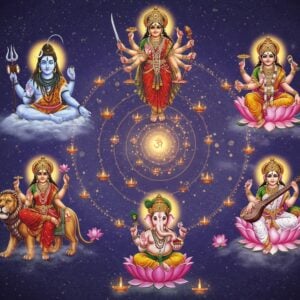
The Dashavatara Stotram and Stuti are revered hymns in Hindu tradition, celebrating Lord Vishnu’s ten incarnations, the Dashavatara. Each avatar signifies a divine intervention to restore balance and righteousness. This blog post delves into the meaning, significance, and cultural context of these sacred texts.
Understanding the Dashavatara
Dashavatara represents the ten incarnations of Vishnu, a principal deity in Hinduism. Each avatar emerges in a specific epoch to protect the universe from malevolence and uphold dharma. These avatars are:
- Matsya (Fish): The savior of the Vedas during the great flood, symbolizing knowledge preservation.
- Kurma (Tortoise): The support of Mount Mandara during the churning of the ocean, representing stability and strength.
- Varaha (Boar): The rescuer of Earth from the ocean depths, demonstrating divine strength and protection.
- Narasimha (Man-Lion): The protector of Prahlada and slayer of Hiranyakasipu, signifying the triumph of good over evil.
- Vamana (Dwarf): The reclaimer of the universe with three strides, showcasing divine power and cosmic balance.
- Parashurama: The warrior who cleansed the earth of wicked Kshatriyas, symbolizing the fight against injustice.
- Rama: The righteous king who defeated Ravana, representing ideal human conduct and devotion to duty.
- Krishna: The divine statesman who guided humanity with wisdom and love, epitomizing divine love and guidance.
- Buddha: The enlightened one who preached compassion and non-violence, emphasizing peace and spiritual awakening.
- Kalki: The future warrior destined to end the Kali Yuga’s darkness, symbolizing hope and ultimate justice.
These incarnations showcase Vishnu’s continuous role in preserving cosmic order and guiding humanity towards righteousness.
Delving into the Dashavatara Stotram
Composed by the celebrated poet Jayadeva as part of his Gita Govinda, the Dashavatara Stotram extols each of Vishnu’s ten avatars. It emphasizes their divine roles in restoring dharma. This hymn is often recited during religious ceremonies and festivals. Find more insightful articles on spiritual growth on our blog.
Exploring the Dashavatara Stuti
The Dashavatara Stuti, another hymn venerating Vishnu’s avatars, is typically integrated into broader rituals and daily prayers. It highlights each avatar’s virtues and deeds, deepening the spiritual connection with Vishnu’s multifaceted nature. Learn more about incorporating celestial energies into your puja practices with our guide on aligning your puja.
The Significance of the Dashavatara Stotram and Stuti Today
These hymns resonate even today, reminding us of the eternal struggle between good and evil. They inspire us to cultivate virtues such as courage, wisdom, and humility. They reflect the cyclical nature of time and symbolize divine intervention in guiding humanity towards moral elevation. For a deeper understanding of Lord Vishnu and his avatars, you can refer to our informative post on Lord Vishnu and his Dashavatars.
Cultural and Ritual Significance of the Hymns
In Indian culture, these hymns are integral to religious practices. Recited during festivals like Janmashtami and Dussehra, they are also essential in temple rituals. They offer devotees a profound spiritual experience, connecting them to their heritage. Explore our article on the science behind Puja for a holistic understanding.
Poojn.in: Your Source for Dashavatara Puja Items
Poojn.in offers a wide variety of products for your Dashavatara worship needs. Enhance your devotion with our curated selection of:
- Idols: Find beautifully crafted Ladoo Gopal idols and Radha Krishna murtis to grace your altar.
- Puja Samagri: Source authentic camphor and other essential items for your rituals.
Visit www.poojn.in today to explore our complete collection.
The Enduring Wisdom of the Dashavatara
The Dashavatara Stotram and Stuti offer profound insights into Hindu tradition. These hymns are a journey through time, reflecting the eternal dance between good and evil. By engaging with these sacred texts, we invite peace, harmony, and blessings into our lives. Create a dedicated space for your worship with our simple guide on creating a Krishna altar.
FAQs about the Dashavatara Stotram and Stuti
What is the purpose of the Dashavatara Stotram? The Dashavatara Stotram praises Lord Vishnu’s ten incarnations, highlighting their divine roles in maintaining cosmic order and righteousness. It expresses devotion and gratitude for Vishnu’s interventions.
What are the key concepts in the Dashavatara Stotram? Key concepts include the idea of ‘Avatara’—God descending to Earth, ‘Dharma’—righteous conduct, and ‘Bhagavan’—referring to Lord Vishnu. Learn more about Krishna’s significance in the Dashavatara by reading our blog on Krishna’s Ten Avatars.
What is the significance of Matsya avatar? Matsya, the fish avatar, saved the Vedas from a devastating flood, symbolizing the preservation of sacred knowledge.
What is the significance of Kurma avatar? Kurma, the tortoise avatar, provided support during the churning of the cosmic ocean, enabling the devas and asuras to obtain amrita, the nectar of immortality. Explore the symbolism of Krishna’s flute in our blog post on Krishna’s Flute Symbolism.
What is the significance of Varaha avatar? Varaha, the boar avatar, rescued the Earth from the depths of the ocean, representing the divine act of preserving the world. Discover the artistic representations of Krishna in our article on Krishna in Art.
How can these hymns help in daily life? Reciting or listening to these hymns fosters spiritual growth, mental peace, and a deeper connection with divine energies. Immerse yourself in devotional music with our curated selection of Krishna Bhajans.


